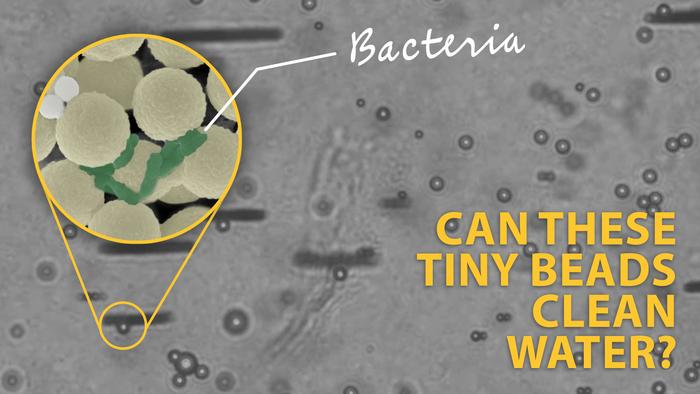When old food packaging, discarded children’s toys and other mismanaged plastic waste break down into microplastics, they become even harder to clean up from oceans and waterways. These tiny bits of plastic also attract bacteria, including those that cause disease. In a study in ACS Nano, researchers describe swarms of microscale robots (microrobots) that captured bits of plastic and bacteria from water. Afterward, the bots were decontaminated and reused. Watch a video of them swarming.

Credit: American Chemical Society
When old food packaging, discarded children’s toys and other mismanaged plastic waste break down into microplastics, they become even harder to clean up from oceans and waterways. These tiny bits of plastic also attract bacteria, including those that cause disease. In a study in ACS Nano, researchers describe swarms of microscale robots (microrobots) that captured bits of plastic and bacteria from water. Afterward, the bots were decontaminated and reused. Watch a video of them swarming.
The size of microplastics, which measure 5 millimeters or less, adds another dimension to the plastic pollution problem because animals can eat them, potentially being harmed or passing the particles into the food chain that ends with humans. So far, the health effects for people are not fully understood. However, microplastics themselves aren’t the only concern. These pieces attract bacteria, including pathogens, which can also be ingested. To remove microbes and plastic from water simultaneously, Martin Pumera and colleagues turned to microscale robotic systems, comprised of many small components that work collaboratively, mimicking natural swarms, like schools of fish.
To construct the bots, the team linked strands of a positively charged polymer to magnetic microparticles, which only move when exposed to a magnetic field. The polymer strands, which radiate from the surface of the beads, attract both plastics and microbes. And the finished products — the individual robots — measured 2.8 micrometers in diameter. When exposed to a rotating magnetic field, the robots swarmed together. By adjusting the number of robots that self-organized into flat clusters, the researchers found that they could alter the swarm’s movement and speed.
In lab experiments, the team replicated microplastics and bacteria in the environment by adding fluorescent polystyrene beads (1 micrometer-wide) and actively swimming Pseudomonas aeruginosa bacteria, which can cause pneumonia and other infections, to a water tank. Next, the researchers added microrobots to the tank and exposed them to a rotating magnetic field for 30 minutes, switching it on and off every 10 seconds. A robot concentration of 7.5 milligrams per milliliter, the densest of four concentrations tested, captured approximately 80% of the bacteria. Meanwhile, at this same concentration, the number of free plastic beads also gradually dropped, as they were drawn to the microrobots. Afterward, the researchers collected the robots with a permanent magnet and used ultrasound to detach the bacteria clinging to them. They then exposed the removed microbes to ultraviolet radiation, completing the disinfection. When reused, the decontaminated robots still picked up plastic and microbes, albeit smaller amounts of both. This microrobotic system provides a promising approach for ridding water of plastic and bacteria, the researchers note.
The authors acknowledge funding from the European Regional Development Fund/Europeal Social Fund project TECHSCALE, the REFRESH program of the European Union and CzechNanoLab.
The paper’s abstract will be available on May 8 at 8 a.m. Eastern time here:
###
The American Chemical Society (ACS) is a nonprofit organization chartered by the U.S. Congress. ACS’ mission is to advance the broader chemistry enterprise and its practitioners for the benefit of Earth and all its people. The Society is a global leader in promoting excellence in science education and providing access to chemistry-related information and research through its multiple research solutions, peer-reviewed journals, scientific conferences, eBooks and weekly news periodical Chemical & Engineering News. ACS journals are among the most cited, most trusted and most read within the scientific literature; however, ACS itself does not conduct chemical research. As a leader in scientific information solutions, its CAS division partners with global innovators to accelerate breakthroughs by curating, connecting and analyzing the world’s scientific knowledge. ACS’ main offices are in Washington, D.C., and Columbus, Ohio.
To automatically receive news releases from the American Chemical Society, contact newsroom@acs.org.
Note: ACS does not conduct research, but publishes and publicizes peer-reviewed scientific studies.
Follow us: X, formerly Twitter | Facebook | LinkedIn | Instagram
Journal
ACS Nano
Article Title
Magnetic Microrobot Swarms with Polymeric Hands Catching Bacteria and Microplastics in Water
Article Publication Date
8-May-2024



